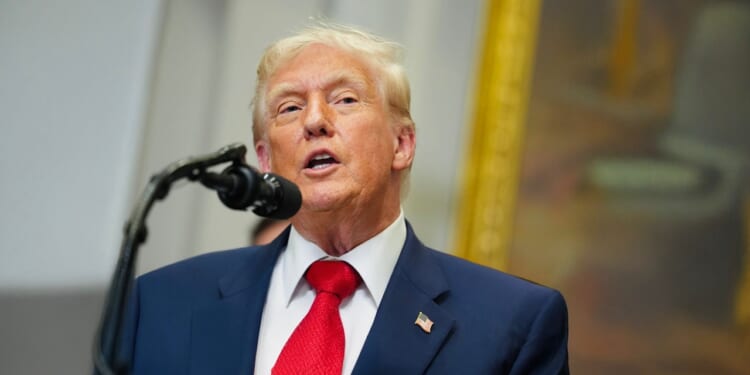During his recent visit to the Middle East, President Donald Trump spoke before the Israeli Knesset and praised the Northrop B-2 Spirit bomber, the aircraft that was used in great effect to strike Iran’s nuclear program back in June. Trump spoke highly of the Spirit—announcing that the United States Air Force would receive an additional 28 of the flying-wing bombers, more than doubling the size of its current fleet.
The aircraft was produced from 1988 until 2000, but only 20 production B-2s and one flight prototype were built during that time. Two were lost in accidents, so today’s fleet consists of just 19 B-2 Spirits, including the prototype.
Trump Called the B-2 Bomber “Beautiful”
In his speech to Israeli lawmakers on October 13, Trump noted that the US “flew seven of those beautiful B-2 bombers” during Operation Midnight Hammer.
“They looked so beautiful all of the sudden. I knew they were pretty planes but I had no clue what they could do what they did. In fact we just ordered 28 more of them. A little updated version. We ordered a whole pile of them,” Trump added.
The American president is known for “riffing,” saying things off the cuff with little factual basis. This has been a signature of his style throughout his career, and should not be understood as a guarantee that the Air Force is actually going to purchase additional B-2s.
However, this wasn’t the first time that the president has made such comments about the bomber. In August, shortly after the strikes, Trump also praised the Spirit—and suggested that additional B-2s had been ordered “in a large number.”
Is the Air Force Really Buying More B-2 Bombers, Though?
There was speculation back in the summer that Trump was referring to the Northrop Grumman B-21 Raider, the next-generation stealth bomber now in the early stages of production. The B-21 made its maiden flight in late 2023, and at least two prototypes have been delivered for continued flight testing.
The Raider is now on track to enter service possibly by the end of 2026 or sometime in early 2027. Current plans call for the Air Force to receive at least 100 B-21 Raiders, although some Air Force officials have suggested the number could be higher. Some defense analysts have argued that as many as 200 to 225 of the bombers could be needed to meet future demands.
Given these facts, it would seem that Trump misspoke about the B-2 when he really meant the B-21 Raider.
Or did he?
During his first term in the White House, Trump infamously (and repeatedly) criticized many of the new technologies on the United States Navy’s Gerald R. Ford-class nuclear-powered supercarriers, notably the Electromagnetic Aircraft Launch System (EMALS). The president argued that the systems were complicated and unreliable, suggesting that time-proven steam catapults should remain—even as EMALS could offer significant advantages if realized.
Since returning to the White House, Trump has also questioned the development of the Navy’s stealth warships, which he called “ugly.” Recently, the real estate mogul turned politician also said he favored the idea of returning the US Navy’s battleships to service, based on the perception of the aesthetic and symbolic power. He also argued that battleships are superior in nature as “bullets are a lot less expensive than missiles.”
Military analysts have been quick to counter Trump’s points on those various issues. Analysts concede that EMALS has had problems, but they also note that it will allow for an increased number of sorties, which could be significant in future combat operations. China’s newest aircraft carrier, the Type 003 Fujian, employs electromagnetic catapults, further highlighting the technology’s potential.
Analysts believe Trump is too focused on appearance rather than capabilities regarding stealth. Regarding battleships, most experts have stated that old warships would be far too vulnerable to modern, long-range missiles, submarine attacks, and stealth aircraft. Moreover, 16-inch shells may be less expensive than missiles, but missiles offer significantly greater range and accuracy.
America Doesn’t Have the Capacity to Build New B-2s Anymore
There have been reports, including from The Jerusalem Post, that support some new production of the B-2 Spirit. It suggested, “With the B-21 Raider still undergoing final testing and not yet fully operational, the upgraded B-2s may serve as a strategic bridge, reinforcing the US Air Force’s long-range strike capacity.”
But the key word here is “upgraded.” It is far simpler to put additional capacities on the existing B-2 airframes than it is to build new ones.
Resuming bomber production would be no simple affair. Production of the B-2 Spirit ended 25 years ago, and the machinery used to build it is long gone. Even if it could somehow be recovered at a reasonable cost, there isn’t a trained staff member who can begin work on such a complex aircraft—and certainly not while the Pentagon’s efforts are tied up supporting the B-21 Raider.
Northrop Grumman is now building the production B-21 on the same manufacturing lines used for the prototypes, a process meant to streamline the production, and one that will ensure it won’t take 12 years to build just 20 bombers. Calling upon the aerospace firm to resume production of the B-2 would only complicate matters, at an immense cost.
“Any such program would face the challenge of reviving production of an aircraft type that ceased manufacturing in 2000, meaning costs could be significantly higher than for incremental upgrades,” Simple Flying explained.
Instead of an entirely new batch of B-2s, Northrop will likely upgrade the existing fleet of Spirits to keep them in the sky well into the late 2030s and beyond. Trump’s off-the-cuff comments will not do much to alter this reality.
About the Author: Peter Suciu
Peter Suciu has contributed over 3,200 published pieces to more than four dozen magazines and websites over a 30-year career in journalism. He regularly writes about military hardware, firearms history, cybersecurity, politics, and international affairs. Peter is also a contributing writer for Forbes and Clearance Jobs. He is based in Michigan. You can follow him on Twitter: @PeterSuciu. You can email the author: [email protected].
Image: Shutterstock / Brian Jason.


















